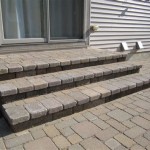Can I Build a Roof Over My Patio? A Comprehensive Guide
Adding a roof over a patio can significantly enhance outdoor living spaces, providing shade, weather protection, and expanding the usability of the area throughout the year. However, before embarking on such a project, it is crucial to consider numerous factors, including legal regulations, structural considerations, materials, and costs. This article aims to provide a comprehensive overview of the key aspects involved in building a roof over a patio.
Understanding Local Building Codes and Regulations
The initial step in determining the feasibility of constructing a patio roof involves researching local building codes and regulations. These codes are put in place to ensure the safety, structural integrity, and aesthetic consistency of construction projects within a specific jurisdiction. Contacting the local building department is paramount to obtain the necessary information and avoid potential legal issues down the line.
Zoning regulations can dictate setbacks, which specify the minimum distance a structure must be from property lines. These setbacks can significantly impact the design and dimensions of the proposed patio roof. Furthermore, height restrictions might limit the overall height of the structure, potentially influencing the roof's pitch and style. Understanding these limitations is critical for developing a realistic and compliant design.
Building permits are typically required for any construction project that alters the structure of a building or adds a permanent fixture. The permit application process usually requires submitting detailed architectural plans, structural engineering calculations, and information about the materials to be used. The building department will review these documents to ensure compliance with all applicable codes. Failing to obtain the necessary permits can result in fines, stop-work orders, and even the requirement to dismantle the unpermitted structure.
Homeowners' associations (HOAs) often have their own set of rules and regulations that govern alterations to properties within their communities. These regulations can be more restrictive than local building codes and might address architectural styles, materials, colors, and the overall aesthetic impact of the project. Before commencing any work, it is imperative to obtain approval from the HOA to avoid potential conflicts and ensure compliance with their requirements.
Environmental regulations may also come into play, particularly if the project involves disturbing protected areas or impacting drainage patterns. In some areas, permits might be required to manage stormwater runoff or to protect sensitive habitats. It is crucial to investigate potential environmental concerns and obtain any necessary approvals before proceeding with the construction.
Assessing Structural Considerations
A patio roof is not merely an aesthetic addition; it is a significant structural element that must be designed and built to withstand various loads, including wind, snow, and the weight of the roofing materials. A proper structural assessment is essential to ensure the safety and longevity of the roof.
The existing structure of the house must be capable of supporting the additional load of the patio roof. This assessment might require the evaluation of the foundation, walls, and roof framing. A structural engineer can conduct a thorough analysis to determine if the existing structure is adequate or if reinforcement is necessary. This is particularly important if the patio roof will be attached directly to the house.
The type of foundation required for the patio roof depends on the size, design, and soil conditions. A simple post-and-beam structure might only require concrete footings for each post, while a more substantial roof might necessitate a continuous foundation wall. The foundation must be designed to resist frost heave, settlement, and other soil-related issues that could compromise the structural integrity of the roof.
The framing of the patio roof must be robust enough to support the roofing materials and withstand environmental loads. Common framing materials include wood, steel, and aluminum. The choice of material depends on factors such as cost, aesthetics, durability, and local building codes. The framing must be properly spaced and secured to ensure adequate strength and stability.
Wind load calculations are essential to ensure that the patio roof can withstand high winds without being damaged or collapsing. These calculations take into account factors such as the wind speed in the area, the shape and size of the roof, and the exposure of the structure to the wind. The framing and connections must be designed to resist the uplift and lateral forces generated by the wind.
Snow load calculations are crucial in areas that experience significant snowfall. The weight of the snow can place a considerable load on the roof, and the framing must be designed to support this load without deflection or failure. The snow load calculations take into account factors such as the average snowfall in the area, the roof's pitch, and the type of roofing material used.
Choosing Appropriate Materials and Designs
The selection of materials and design for a patio roof is a crucial decision that impacts the aesthetic appeal, durability, and cost of the project. A wide range of options are available, each with its own advantages and disadvantages.
Wood is a popular choice for patio roofs due to its natural beauty, versatility, and relatively low cost. Common wood species used include cedar, redwood, and pressure-treated lumber. Wood can be stained or painted to match the existing house or to create a unique look. However, wood is susceptible to rot, insect damage, and weathering, requiring regular maintenance to ensure its longevity.
Metal is a durable and low-maintenance option for patio roofs. Steel and aluminum are commonly used, offering excellent strength and resistance to the elements. Metal roofs can be painted or coated to match the house and are available in a variety of styles, including corrugated panels and standing seam roofs. While metal roofs are more expensive than wood, they offer a longer lifespan and require less maintenance.
Composite materials, such as fiberglass and vinyl, offer a combination of durability, low maintenance, and aesthetic appeal. These materials are resistant to rot, insect damage, and weathering, making them ideal for outdoor applications. Composite roofs are available in a variety of colors and styles, mimicking the look of wood or other traditional roofing materials.
The design of the patio roof should complement the style of the house and the surrounding landscape. Common roof designs include gable roofs, shed roofs, and flat roofs. Gable roofs offer good drainage and ventilation, while shed roofs are simple and cost-effective. Flat roofs are often used for modern designs and can be used as additional outdoor living space.
The choice of roofing material also impacts the overall aesthetic and performance of the patio roof. Asphalt shingles are a cost-effective option, while tile roofs offer a more traditional and durable look. Metal roofs are available in a variety of colors and styles, providing a sleek and modern appearance. The roofing material should be chosen to match the house and to provide adequate protection from the elements.
Consideration should also be given to features such as gutters and downspouts, which are essential for managing rainwater runoff. Gutters should be properly sized and installed to prevent water from pooling on the roof or damaging the foundation. Downspouts should direct the water away from the house and into a drainage system.
Finally, the integration of lighting and electrical outlets can enhance the functionality and enjoyment of the patio roof. Lighting can create a warm and inviting atmosphere, while electrical outlets provide power for outdoor appliances and entertainment systems. All electrical work should be performed by a licensed electrician to ensure safety and compliance with local codes.

How Much Does It Cost To Build A Roof Over My Deck Or Patio In Colorado

How Much Does It Cost To Build A Roof Over My Deck Or Patio In Colorado

How To Build A Roof Over My Existing Deck Costs Designs

How Much Does It Cost To Build A Roof Over My Deck 2024 Data

Adding A Roof Over Your Deck Is It Worth Decks R Us Blog

Patio Cover Plans Build Your Or Deck

How To Build A Roof Over My Existing Deck Costs Designs

Build A Roof On Your Deck To Enjoy Outdoor Space Regardless Of The Weather Building Pergola

How Much Does Adding A Roof Over Patio Cost 2024

How Much Does It Cost To Build A Roof Over My Deck 2024 Data
Related Posts








